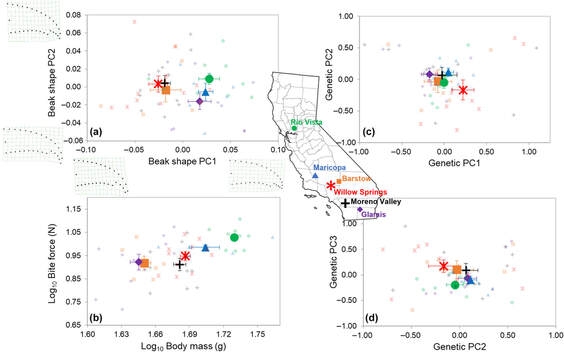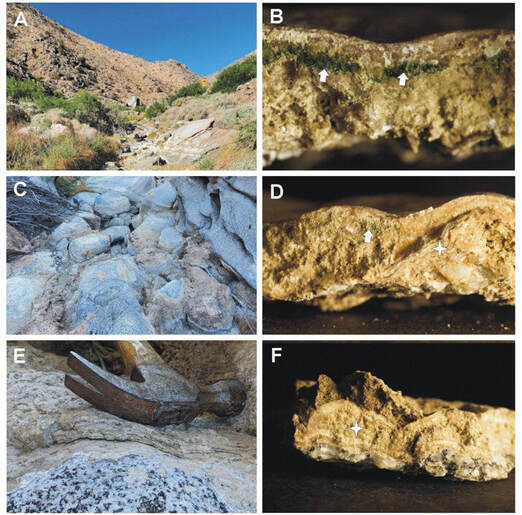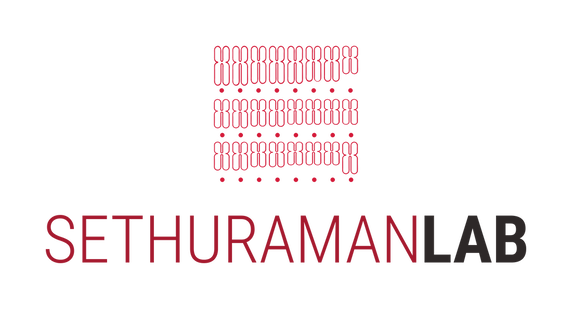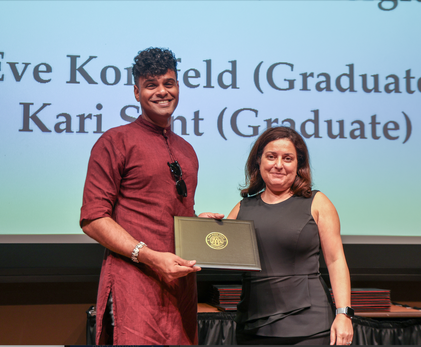Loggerhead shrike pop-gen + geometric morphometrics manuscript published in Ecology and Evolution!3/19/2024  Location means ± SE along bivariate phenotypic (left side) and genetic (right side) spaces: (a) The first two principal component axes of upper beak shape, including shape deformation grids showing shape differences along the extremes of each axis; (b) log10 bite force vs. log10 body mass; (c) the first two axes of the genetic principal component analysis based on microsatellite data; (d) the second and third axes of the genetic PCA. Symbol color and shape combinations correspond to different sampling locations throughout California labeled on the map (individual data points are semi-transparent). Our manuscript that describes phenotypic differences despite the presence of little population structure and lots of gene flow between Californian populations of the loggerhead shrike, Lanius ludovicianus is now published in Ecology and Evolution! Congratulations to Sethuraman Lab alum, Gwen Wulf on this publication! Read the paper here.
0 Comments
 The ephemeral San Felipe Creek in Anza Borrego Desert (A). Samples were collected from the surface of boulders found in the bed of the desiccated creek (C and E). Samples imaged under a dissecting scope (B, D, and F) show characteristic features of stromatolites including endolithic cyanobacteria underneath a layer of calcite (arrows in panels B and D) and multiple laminate layers of organic and inorganic materials (asterisks in panels D and F). DNA was isolated from the stromatolites shown in panels B and E. Our article describing the microbial metagenome of calcareous stromatolite formations in the Anza Borrego desert in California, led by talented NSF REU scholars from Summer 2022/2023 has now been published in the American Society for Microbiology's Resource Announcements. Read the article here!
The Sethuraman Lab recently presented our research at the TAGC24 meeting in Washington D.C., with PhD student Margaret Wanjiku giving a talk on her first thesis chapter on a series of statistical tests to detect and account for gene flow from archaic ghost populations, PhD student Alexandra McElwee-Adame presenting a poster on her first thesis chapter on the evolutionary genomics of domestication in hops (Humulus lupulus L.), MS candidate Priyanshi Shah presenting her work on telomere length variation in diverse human populations, and Undergraduate student Scott Monahan presenting work on heritability and plasticity in body size of Dinocampus coccinellae, a parthenogenetic wasp. We also had a grand time being tourists around D.C.! Cheers to more fun science meetings in the future! Dr. Sethuraman was recently awarded the 2024 SDSU Research, Scholarship, & Creative Activities Mentor Award, which was presented by Dr. Hala Madanat, Vice President for Research & Innovation at the S3 symposium.
The Sethuraman Lab recently presented results from numerous projects at the SDSU Student Symposium (S3) - Raya on her Undergraduate capstone work, developing a new tool called speciel for developing SNP arrays to identify trout species, Tamsen on her PhD work, utilizing Ks distributions to estimate and distinguish timing of allo- and auto-polyploidization events, and Priyanshi on her MS thesis on quantifying telomere length variation in diverse human populations, and the development of a deep learning framework to estimate tumor status. Priyanshi was awarded the Provost's Award for the Sciences, and Tamsen was awarded the Excellence in Graduate Thesis Award! Congratulations to both of them!
|
Arun Sethuraman
|


 RSS Feed
RSS Feed